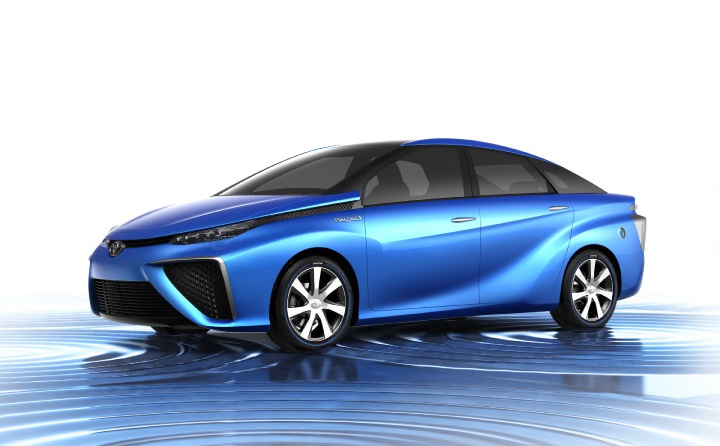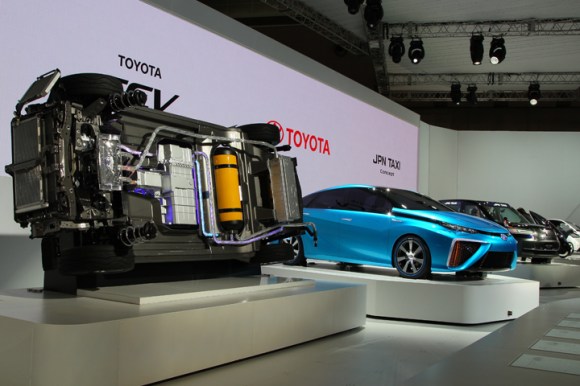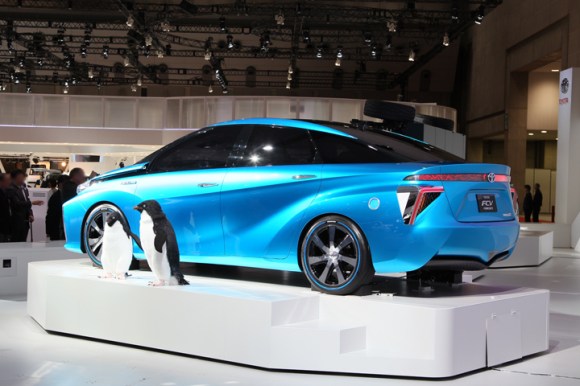
Although the technology has been talked about for quite some time now, the concept of using oxygen and hydrogen to power an automobile seems poised to finally hit the market.
According to reports, the Toyota Motor Corporation has recently declared that their sedan-type Fuel Cell Vehicle (FCV) will begin production at the end of this year. At the moment Toyota claims this would make them the first automaker in the world to market such a vehicle to the public at large.
The FCV carries a stock of hydrogen on board and uses oxygen from the air to generate power. It’s said that a single 5kg (11lbs) supply of hydrogen can carry Toyota’s FCV over 500km (310mi). This is probably a good thing since at the time of its initial launch, stations where hydrogen can be purchased will be few and far between, found in only four of Japan’s major urban centers: Tokyo, Nagoya, Osaka, and Fukuoka.
It’s also been reported while that the establishments of around 100 of these stations have been expected to occur over this year, they are currently behind schedule. As such the Japanese government has been stepping in to encourage faster development.
Like many new technologies, the FCV will initially sell for a high price. Previously it was expected to cost 10,000,000 yen (US$97,500), but as of this writing has been marked down to an expected 9,900,000 yen ($96,500) with hopes that certain subsidies will kick in and lower the price further over the year.
Toyota is aware that these vehicles aren’t going to sell like hotcakes in the early days and will only produce 50 cars a month when ready. The company is mainly aiming at national and local governments as well as wealthy individuals or corporations with a particular interest in eco-friendly cars as potential buyers. As such someone should probably consider setting up hydrogen stands in the ritzier parts of Japan as well.
Readers of the news reacted with cautious optimism. Several asked the questions “Where does the hydrogen come from?” and “In what way do we get the hydrogen?” The first question is by far the most important, as the method that the pure hydrogen is produced may cause a substantial amount pollution as well thus negating the whole environmental aspect of the car.
With regards to the latter question, when I first heard about hydrogen fuel cells I always imagined/hoped it’d be like those glowing energon cubes from the Transformers series, but based on this promotional video from last year it looks like you just pump the hydrogen into a tank like you do with regular old gasoline. However, this also begs the question: How much will the hydrogen cost?
Indeed, it’ll be a hard road ahead for the FCV with challenges in infrastructure, pricing, and public attitude to contend with. However, if this is truly the start of a wave of automobiles producing a small fraction of the emissions of regular combustion engines, my grey boogers may one day vanish into nothing more than bedtime stories for my grandchildren.
Source: Tokyo Web via My Game News Flash (Japanese)
Images & Video: Toyota



 Honda readying a Fuel Cell Vehicle for buyers next year, just in time to challenge Toyota
Honda readying a Fuel Cell Vehicle for buyers next year, just in time to challenge Toyota Japan’s hydrogen fuel cell stations begin to open, but are they worth the switch?
Japan’s hydrogen fuel cell stations begin to open, but are they worth the switch? Japan’s JAXA wants to build a fuel processing plant on the surface of the moon
Japan’s JAXA wants to build a fuel processing plant on the surface of the moon Hugh Jackman stars, sings J-pop cover, and speaks Japanese in ads for Toyota【Videos】
Hugh Jackman stars, sings J-pop cover, and speaks Japanese in ads for Toyota【Videos】 Real Fullmetal Alchemists: Kyoto University team fuses all 8 precious metals into single alloy
Real Fullmetal Alchemists: Kyoto University team fuses all 8 precious metals into single alloy New Nintendo Lego kit is a beautiful piece of moving pixel art of Mario and Yoshi【Photos】
New Nintendo Lego kit is a beautiful piece of moving pixel art of Mario and Yoshi【Photos】 How to order snacks on a Shinkansen bullet train in Japan
How to order snacks on a Shinkansen bullet train in Japan Hello, cosmetics! Clinique teams up with Hello Kitty this summer for first-time collaboration
Hello, cosmetics! Clinique teams up with Hello Kitty this summer for first-time collaboration Demon Slayer: Kimetsu no Yaiba gets new roller coaster attractions and food at Universal Studios Japan
Demon Slayer: Kimetsu no Yaiba gets new roller coaster attractions and food at Universal Studios Japan McDonald’s adds new watermelon frappe and fruity macaron to its menu in Japan
McDonald’s adds new watermelon frappe and fruity macaron to its menu in Japan Cosmetic wizardry: Asian women removing makeup to reveal their true selves goes viral【Video】
Cosmetic wizardry: Asian women removing makeup to reveal their true selves goes viral【Video】 Tsukiji Fish Market Vendor Releases Tuna For Home Assembly
Tsukiji Fish Market Vendor Releases Tuna For Home Assembly High-fashion Totoro cuddle purse is like an elegant stroll in the forest【Photos】
High-fashion Totoro cuddle purse is like an elegant stroll in the forest【Photos】 U.S. Olympic athlete reveals he runs with Yi-Gi-Oh! cards tucked into his uniform【Video】
U.S. Olympic athlete reveals he runs with Yi-Gi-Oh! cards tucked into his uniform【Video】 Japan’s new difficult-to-drink-from beer glass protects your liver, but it’s a brutal experience
Japan’s new difficult-to-drink-from beer glass protects your liver, but it’s a brutal experience Nintendo history you can feel – Super NES, N64, and GameCube controllers become capsule toys
Nintendo history you can feel – Super NES, N64, and GameCube controllers become capsule toys “The most Delicious Cup Noodle in history” – Japan’s French Cup Noodle wins our heart【Taste test】
“The most Delicious Cup Noodle in history” – Japan’s French Cup Noodle wins our heart【Taste test】 Starbucks releases a cute Frappuccino and Unicorn Cake…but not in Japan
Starbucks releases a cute Frappuccino and Unicorn Cake…but not in Japan Kyoto Tower mascot termination reveals dark side behind cute Japanese characters
Kyoto Tower mascot termination reveals dark side behind cute Japanese characters McDonald’s Japan’s Soft Twist Tower: A phantom ice cream only sold at select branches
McDonald’s Japan’s Soft Twist Tower: A phantom ice cream only sold at select branches Yabai Ramen: What makes this Japanese ramen so dangerous?
Yabai Ramen: What makes this Japanese ramen so dangerous? Finally! Nintendo Japan expands Switch 8-bit controller sales to everybody, Online member or not
Finally! Nintendo Japan expands Switch 8-bit controller sales to everybody, Online member or not Japanese government wants to build luxury resorts in all national parks for foreign tourists
Japanese government wants to build luxury resorts in all national parks for foreign tourists To combat declining birth rate, Japan to begin offering “Breeding Visas” to foreigners
To combat declining birth rate, Japan to begin offering “Breeding Visas” to foreigners 10 things you should buy at 7-Eleven in Japan
10 things you should buy at 7-Eleven in Japan Studio Ghibli releases anime heroine cosplay dresses that are super comfy to wear
Studio Ghibli releases anime heroine cosplay dresses that are super comfy to wear Woman charged for driving suitcase without a license in Osaka
Woman charged for driving suitcase without a license in Osaka Studio Ghibli unveils My Neighbour Totoro miniature house model
Studio Ghibli unveils My Neighbour Totoro miniature house model Kyoto experiencing problems with foreign tourists not paying for bus fares, but not on purpose
Kyoto experiencing problems with foreign tourists not paying for bus fares, but not on purpose Fighting mild hunger with a Japanese soda that turns into jelly in the stomach【Taste test】
Fighting mild hunger with a Japanese soda that turns into jelly in the stomach【Taste test】 Studio Ghibli’s Howl’s Moving Castle tapestry unveiled in Japan for first time
Studio Ghibli’s Howl’s Moving Castle tapestry unveiled in Japan for first time McDonald’s new Happy Meals offer up cute and practical Sanrio lifestyle goods
McDonald’s new Happy Meals offer up cute and practical Sanrio lifestyle goods Sales of Japan’s most convenient train ticket/shopping payment cards suspended indefinitely
Sales of Japan’s most convenient train ticket/shopping payment cards suspended indefinitely Sold-out Studio Ghibli desktop humidifiers are back so Totoro can help you through the dry season
Sold-out Studio Ghibli desktop humidifiers are back so Totoro can help you through the dry season Japanese government to make first change to romanization spelling rules since the 1950s
Japanese government to make first change to romanization spelling rules since the 1950s Foreigner’s request for help in Tokyo makes us sad for the state of society
Foreigner’s request for help in Tokyo makes us sad for the state of society Ghibli founders Toshio Suzuki and Hayao Miyazaki contribute to Japanese whisky Totoro label design
Ghibli founders Toshio Suzuki and Hayao Miyazaki contribute to Japanese whisky Totoro label design Doraemon found buried at sea as scene from 1993 anime becomes real life【Photos】
Doraemon found buried at sea as scene from 1993 anime becomes real life【Photos】 Tokyo’s most famous Starbucks is closed
Tokyo’s most famous Starbucks is closed Princesses, fruits, and blacksmiths: Study reveals the 30 most unusual family names in Japan
Princesses, fruits, and blacksmiths: Study reveals the 30 most unusual family names in Japan North Korea claims successful hydrogen bomb test, world very skeptical
North Korea claims successful hydrogen bomb test, world very skeptical Nestlé Japan to release gold Kit Kats this December
Nestlé Japan to release gold Kit Kats this December Japan government makes cute illustrated version of radioactive isotope it plans to dump into sea
Japan government makes cute illustrated version of radioactive isotope it plans to dump into sea Toyota proposes a future where cars become pizza shops, hotels, and occasionally cars too
Toyota proposes a future where cars become pizza shops, hotels, and occasionally cars too Japanese teens develop anti-fart underwear that blocks smell and sound of flatulence
Japanese teens develop anti-fart underwear that blocks smell and sound of flatulence Take a tour of the Fukushima Daiichi Nuclear Power Plant seven years after the disaster 【Video】
Take a tour of the Fukushima Daiichi Nuclear Power Plant seven years after the disaster 【Video】 China to remove six million cars from its roads in an effort to make city air breathable again
China to remove six million cars from its roads in an effort to make city air breathable again Synthetic fossil fuels made from light, water, and CO2 in the air tested in Osaka
Synthetic fossil fuels made from light, water, and CO2 in the air tested in Osaka Japanese researchers redesign electric car to go farther than ever before on a single charge
Japanese researchers redesign electric car to go farther than ever before on a single charge Breathe easy – Toyota redesigning Prius plug-in hybrid to double car’s all-electric range
Breathe easy – Toyota redesigning Prius plug-in hybrid to double car’s all-electric range Kansai man arrested for defrauding his 35 girlfriends
Kansai man arrested for defrauding his 35 girlfriends Kyoto Animation arson attack prompts call for stricter gas sale regulations in Kyoto
Kyoto Animation arson attack prompts call for stricter gas sale regulations in Kyoto Kamen Rider Revi’s hoverbike is a real thing that’s on sale now, delivery by early next year
Kamen Rider Revi’s hoverbike is a real thing that’s on sale now, delivery by early next year Go to hell: Unzen Hot Springs invites visitors to take an infernal stroll through a field of deadly hell-mouths
Go to hell: Unzen Hot Springs invites visitors to take an infernal stroll through a field of deadly hell-mouths Drivers spill the beans while saving the planet with Nissan’s two-seater electric vehicle
Drivers spill the beans while saving the planet with Nissan’s two-seater electric vehicle
Leave a Reply